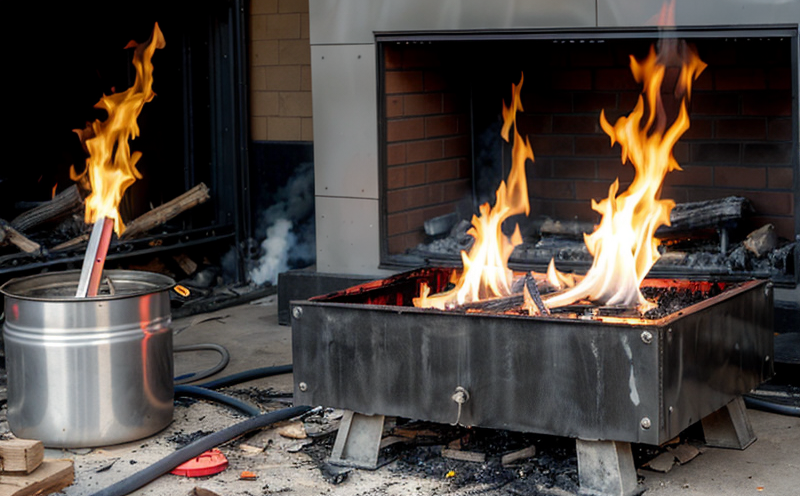ISO 9239 1 Reaction to Fire Testing for Floorings
The ISO 9239-1 standard is a globally recognized method used in testing floorings to determine their resistance to ignition and the rate of flame spread. This test, often referred to as "Reaction to Fire" or "Flammability Testing," assesses how quickly flames will spread across flooring samples under controlled conditions and evaluates the time it takes for the flames to extinguish once they are removed from a heat source.
This testing is critical in ensuring that floorings meet safety standards, particularly in high-risk areas such as hospitals, schools, public buildings, and residential complexes. The test results provide valuable insights into the fire performance characteristics of different flooring materials, helping architects, builders, and material suppliers select appropriate products for specific applications.
The testing process involves exposing a standardized sample to a flame under controlled conditions, measuring the rate at which flames spread across the surface, and recording the time it takes for the flames to extinguish. The results are compared against specified thresholds in the ISO 9239-1 standard, providing a clear indication of the material’s fire resistance.
Understanding the significance of this test is essential for those involved in quality management, compliance officers, and R&D engineers. It offers them the opportunity to ensure that their products meet international standards and are safe for use in various environments. For procurement specialists, it helps in selecting suppliers who adhere to stringent quality control measures.
Testing according to ISO 9239-1 is not just about compliance; it’s about ensuring safety and protecting lives. In healthcare facilities, where even a small fire can have severe consequences, this test plays an indispensable role in safeguarding against potential disasters. By adhering to these standards, manufacturers contribute to the overall safety and reliability of their products.
The testing protocol is designed with precision and repeatability in mind, ensuring that results are consistent across different laboratories and test runs. This consistency is crucial for maintaining confidence in the outcomes and facilitating comparisons between various materials. The process involves rigorous specimen preparation, controlled environmental conditions, and detailed documentation to ensure accurate and reproducible results.
Understanding the nuances of this testing can help stakeholders make informed decisions about product selection and quality assurance. For instance, knowing the exact flame spread index (FSI) or smoke density values for different flooring materials allows architects and builders to choose products that not only meet regulatory requirements but also enhance safety in high-risk areas.
The importance of ISO 9239-1 testing cannot be overstated, especially when considering the potential consequences of material choice on public safety. By adhering to these standards, manufacturers contribute significantly to creating safer environments for occupants and visitors alike.
Applied Standards
| Standard | Description |
|---|---|
| ISO 9239-1 | This standard specifies the method for determining the reaction to fire characteristics of floorings exposed to a flame. It includes procedures for testing under controlled conditions and interpreting results. |
| ASTM E648 | American Society for Testing Materials (ASTM) standard that provides guidelines for the preparation and conditioning of specimens used in flammability tests. |
| IEC 60332-1 | This international standard sets out the requirements for testing the fire retardancy of insulated conductors. While not directly related to floorings, it provides a broader context for understanding material flammability. |
Scope and Methodology
| Aspect | Description |
|---|---|
| Samples | The test is conducted on standardized flooring samples that are conditioned to a specified temperature for at least 4 hours. The samples should be free from any surface contaminants. |
| Flame Source | A propane torch with a nominal flame length of approximately 10 cm is used as the heat source. The flame is applied for exactly 60 seconds, and the time it takes for the flames to extinguish is recorded. |
| Measurement | The rate at which flames spread across the sample surface is measured using a calibrated measuring device. Additionally, the total burning time of the sample under flame exposure is recorded. |
The methodology ensures that all tests are conducted in a consistent and reproducible manner, providing reliable data for comparison and compliance assessment.
Why Choose This Test
- Regulatory Compliance: Ensures adherence to international standards such as ISO 9239-1.
- Safety Assurance: Provides critical data on fire resistance, helping prevent potential safety hazards.
- Risk Management: Identifies materials with lower risk of fire spread in high-risk areas.
- Quality Control: Offers a standardized method for evaluating the performance of flooring products under controlled conditions.
- Cost Efficiency: Early identification of non-compliant materials can save costs associated with rework or recalls.
- Client Confidence: Demonstrates commitment to high-quality and safety standards, enhancing client trust.
The ISO 9239-1 test is an indispensable tool for ensuring the safety and quality of floorings in various environments. By choosing this test, stakeholders can make informed decisions that contribute to a safer built environment.





